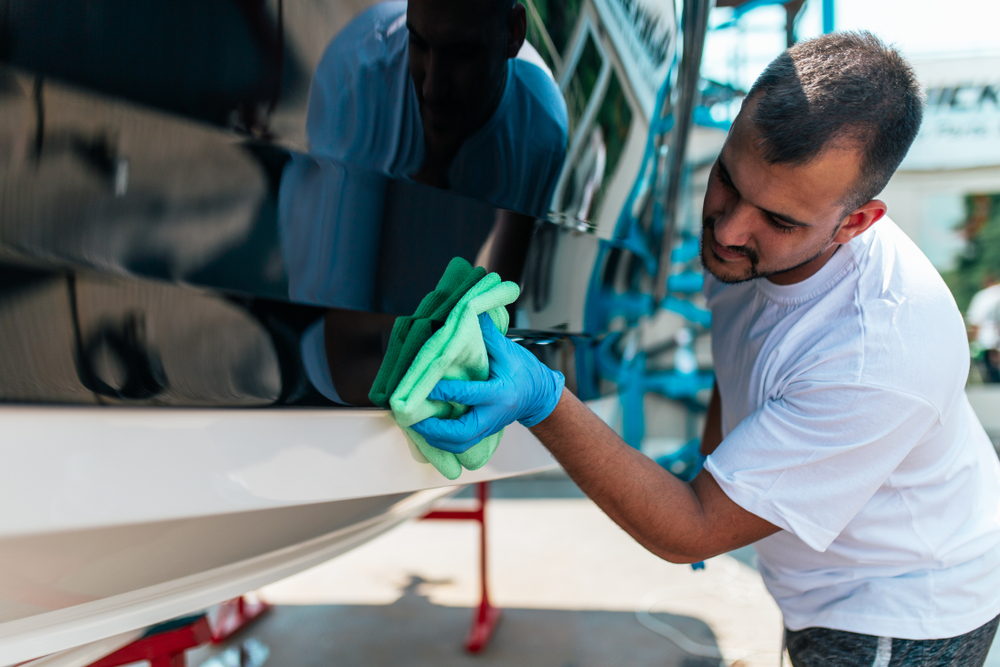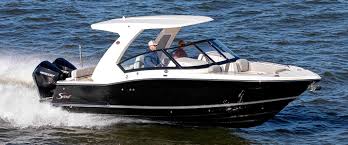Best Boat Wax 2024: Top Picks for Ultimate Protection and Shine
Boat enthusiasts and owners are well aware that maintaining their vessels is crucial for preserving their investment and ensuring their boat looks great on the water. One essential aspect of boat maintenance is the application of boat wax.

Boat wax not only enhances the appearance of a boat but also provides protection from various nautical and environmental hazards. As we sail into 2024, new boat wax products are hitting the market with innovative formulas and improved performance, making it more important than ever to find the best option for your vessel.
Understanding the different types of boat waxes and their benefits is key to making the right choice. The ideal boat wax should provide a long-lasting, glossy finish while offering protection against UV rays, saltwater, and other damaging elements. In addition, ease of application and environmental considerations should also be factored in when selecting the best boat wax for your specific needs.

Key Takeaways
- Boat wax is essential for maintaining and protecting your investment while enhancing its appearance
- The best boat wax for 2024 should offer long-lasting shine and protection against environmental hazards
- Consider factors like ease of application and environmental impact when selecting a boat wax
Understanding Boat Wax
Types of Boat Waxes
Boat waxes can be categorized into different types based on their composition, form, and function. Here are the main types:
- Carnauba Wax: Carnauba wax is a natural wax sourced from the leaves of a Brazilian palm tree. It offers good UV protection and produces a high-gloss finish.
- Synthetic Wax: Synthetic waxes are made from polymers and provide long-lasting protection. They are more durable than natural waxes like carnauba.
- Cleaner Wax: This type of wax is formulated with mild abrasives that help remove dirt, oxidation, and minor imperfections from the gel coat while providing protection and shine.
- Restorer Wax: Restorer waxes are designed specifically for heavily oxidized, faded, or scratched surfaces. They contain strong cleaning agents and may also include polishing compounds.
- Paste Wax: Paste waxes have a thicker consistency than liquid waxes, which might make them harder to apply, but they often provide longer-lasting protection.

Selecting the Right Wax Type
When choosing a boat wax, consider the following factors:
- Material: Ensure that the wax is compatible with your boat's surface material. For example, aluminum boats require special waxes, such as the Woody Wax Tower Treatment System.
- Condition: Evaluate the condition of your boat's surface. If it has heavy oxidation or scratches, a restorer wax or cleaner wax would be a better choice.
- Desired Finish: If you want a high-gloss shine, opt for a carnauba wax or a wax offering that specific finish.
- Ease of Application: Liquid waxes are generally easier to apply than paste waxes, but they may not last as long.
Wax vs. Polish: What's the Difference?
Wax and polish are often used interchangeably, but they serve different purposes:
- Wax: A boat wax provides a protective layer, offering UV protection, glossy finish, and preventing dirt from sticking to the surface. Examples include the Meguiar's Flagship Premium Marine Wax and 3M 09062 Marine Liquid Wax.
- Polish: A boat polish, on the other hand, is primarily used to remove imperfections and restore shine. The polishing process may involve the use of abrasives, compounds, and swirl removers. An example is the Meguiars Gelcoat Restoration Kit.
The Benefits of Regular Waxing
Protection Against UV Damage
One of the key benefits of waxing your boat is protection against UV damage. Sun exposure is a common cause of deterioration for fiberglass boats. Using a high-quality wax not only protects the gel coat from UV rays but also preserves the boat's vibrant colors and prevents oxidation.
Maintaining a High-Gloss Finish
Boat owners often desire a high-gloss finish for their vessels. Regular waxing helps maintain this glossy appearance while also providing a barrier against dirt, water, and other environmental contaminants. A well-maintained glossy finish enhances the boat's visual appeal and can make it stand out at the dock or on the water.
Preserving Resale Value
A well-waxed boat is not only more aesthetically pleasing but also more likely to have a higher resale value. Waxing safeguards the boat's surface, ensuring that it remains protected from UV damage, oxidation, and potential degradation. Regular maintenance, including waxing, keeps the boat in optimal condition and can attract potential buyers when it's time to sell.
Comparative Reviews of Top Boat Waxes for 2024
Carnauba-Based Waxes
Carnauba-based waxes are popular for their natural shine and outstanding water repellency. Derived from the leaves of the Brazilian carnauba palm, this wax offers a deep and glossy finish. An example of a high-quality carnauba-based wax is the Collinite brand.
This boat wax not only provides a lasting shine but also boasts impressive durability and high resistance to harsh marine elements.
Synthetic Polymer Waxes
Synthetic polymer waxes, like 3M Marine and Scotchgard Marine Liquid Wax, are formulated to provide long-lasting protection for marine surfaces such as gel coat and fiberglass.
These waxes create a glossy finish and offer strong protection against UV damage and oxidation. Moreover, synthetic polymer waxes can be applied with minimal effort, making them a user-friendly choice for boaters.
Some top synthetic polymer waxes include:
- 3M Marine: Known for its easy application and excellent sun damage protection.
- Scotchgard Marine Liquid Wax: Provides a beautiful gloss finish while also protecting your boat's paintwork from fading.
Cleaner Waxes for Minor Imperfections
Cleaner waxes are designed to not only protect the surface but also remove minor imperfections like light oxidation, scratches, and stains. Meguiar's Flagship Premium Marine Wax is one such cleaner wax that effectively tackles minor issues on marine surfaces and leaves an impressive shine.
Another notable cleaner wax with exceptional performance is Star Brite. This product offers excellent cleaning abilities, making it suitable for use on lightly oxidized and stained surfaces. It doesn't require intense rubbing, ensuring an easier application process.
Application Techniques and Tips
Surface Preparation
Before applying any boat wax, proper surface preparation is essential for achieving the best results. Start by rinsing the boat's surface with water and using a clean, wet sponge to wipe off any dirt and grime.
For stubborn stains or oxidation, use a fine-grain sandpaper to gently scrub the affected areas. It's crucial to remove all contaminants that may affect the wax's performance and adherence to the boat's surface.
Applying Wax by Hand vs. Machine
There is a debate between hand application and machine application when it comes to boat wax.
Hand application is considered a popular technique because it ensures a more controlled and precise application. This method allows for better coverage of every inch of your boat, ensuring it is properly coated with wax. To perform hand application, use a clean, lint-free cloth or applicator pad and apply the wax using a circular motion.
In contrast, machine application with a buffer or polisher can save time and effort. It helps achieve uniform coverage, especially for larger boat surfaces. However, machine application requires extra care to avoid damaging the gelcoat or applying too much pressure.

Minimizing Application Errors
Understanding proper application techniques is crucial for maximizing the benefits of the chosen boat wax. To minimize errors, consider the following points:
- Beading: Ensure the wax you choose provides effective beading, which allows water to slide off the surface easily and prevents moisture buildup.
- Cleaner waxes: Some boat owners prefer cleaner waxes that combine cleaning agents and protective wax in a single product. These can be useful as a one-step solution but may not provide the same level of protection as dedicated waxes.
- Application method: Select an application method, either by hand or machine, based on your comfort level and the size of your boat. Remember to avoid applying excessive pressure, which can harm your boat's gelcoat.
- Oxidation: Ensure the wax effectively removes light oxidation and prevents further deterioration. Some boat waxes are specifically designed to tackle oxidation issues.
- Stains: Choose a boat wax that not only protects the surface against future stains but also helps remove existing ones.
Maintaining Your Boat's Shine
Routine Waxing Intervals
To preserve your boat's exterior and ensure it looks its best, it's important to establish routine waxing intervals.
Generally, boats should be waxed at least once or twice a year, depending on usage and environmental conditions.
Regularly waxing your boat helps protect it from harmful UV rays, water spots, and dirt.
It is ideal to wax your boat when it's neither too wet nor too dry.
Some top-rated boat waxes for 2024 can be found on Sail Reviews and Boat Safe.
Cleaning After a Day on the Water
After a day of cruising on the water, it's essential to give your boat a thorough cleaning to eliminate any buildup of salt, dirt, or grime.
Use a gentle boat cleaner and soft brush to clean all surfaces, including the deck, hull, and gear.
Be sure to rinse the boat thoroughly to remove any remaining residue.
Doing this cleaning step before waxing will help the wax adhere better and last longer.
Avoid cleaning your boat under direct sunlight, as it may cause streaks and make the cleaning process more challenging.
Enhancing Longevity of the Wax
To extend the lifespan of the wax and maintain your boat's shine, follow these simple tips:
- Store your boat properly: Keep your boat covered and stored in a shaded area whenever possible, as exposure to direct sunlight can cause the wax to degrade faster.
- Avoid unnecessary contact: Minimize contact with the boat's surfaces, including leaning against or dragging gear across the hull, as this can wear down the wax.
- Watch for signs of deterioration: Pay attention to any signs of wax wearing off, such as dullness or water spots, and reapply wax as needed.
- Choose the right wax for your boat: Invest in a high-quality boat wax, such as one of the 11 Best Boat Waxes in 2024, that provides proper protection and UV resistance for your specific boat type and material.
Special Considerations
Dealing with Salt Water and Pollutants
Boat wax plays an essential role in protecting your vessel from harsh marine elements, including salt water, wind, and pollutants. Extended exposure to these elements can cause oxidation and degrade the boat's surface.
To ensure your boat remains in optimal condition, you must select a wax with excellent protective properties against salt water and pollutants.
- Salt water: Choose a boat wax that provides a barrier against the corrosive effects of salt water. The Meguiar's Flagship Premium Marine Wax is one example of a product offering exceptional protection against salt water damage.
- Wind: Wind can carry dirt and debris that may scratch your boat's surface. A high-quality wax can help seal the surface and prevent wind-driven abrasives from causing damage.
- Pollutants: Pollutants like oil and fuel residues can stick to your boat's surface. Opt for a wax that prevents the buildup of these harmful substances and makes cleaning easier.
Waxing Non-Skid Decks and Other Unique Surfaces
Waxing can be particularly challenging for non-skid decks and other unique surfaces. An essential consideration when waxing these surfaces is to maintain their non-slip properties. Here are some tips for waxing non-skid decks and other unique surfaces:
- Use a specialized non-skid wax designed specifically for these surfaces. Examples include the Woody Wax Tower Treatment System, which is suitable for aluminum boats and non-skid decks.
- Apply the wax carefully to avoid making the surface slippery.
- Use a soft brush to ensure a thorough yet safe application.
Topside Paints and Coatings
Topside paints and coatings require special care when waxing, as they may have a clear coat that can be sensitive to particular types of waxes. To keep your boat's topside paint and coating in great condition, consider the following:
- When waxing painted surfaces, use a non-abrasive wax specifically formulated for topside paints and coatings. Meguiar's Boat Wax is an example of a suitable product, as mentioned in Sail Reviews.
- Apply wax to a small area first as a test to avoid potential damage to the entire paint job.
- Regular boat wax will not adhere to clear coat surfaces. Instead, use a clear coat-safe wax or polish specifically designed for use on these surfaces.
Environmental Impact and Boat Care
Eco-Friendly Waxing Products
In an effort to minimize environmental impact, many boating enthusiasts are turning to eco-friendly waxing products to maintain their vessels.
One such product is the Hula Boatcare Hang Ten Cleaner Wax, which is known for its environmentally safe ingredients.
These types of waxes not only protect the boat's surface but also promote sustainability and leave a minimal ecological footprint.
Additionally, it is crucial to select a wax that is designed specifically for marine use.
Products like Meguiar's Flagship Premium Marine Wax or the Meguiar's Gelcoat Restoration Kit provide long-lasting protection and gloss while being gentle on the environment.
Here are a few recommended eco-friendly waxing products:
- Hula Boatcare Hang Ten Cleaner Wax
- Meguiar's Flagship Premium Marine Wax
- Meguiar's Gelcoat Restoration Kit
Reducing Fuel Consumption Through Aerodynamics
Another aspect of boat care that indirectly impacts the environment is fuel efficiency.
By maintaining the boat's surfaces with proper waxing and polish, the drag coefficient reduces, directly improving the boat's aerodynamics.
Enhanced aerodynamics lead to reduced fuel consumption, which in turn, is beneficial to the environment.
Furthermore, optimizing the boat's speed and weight distribution can also contribute to fuel efficiency.
Regular maintenance checks and keeping the boat's hull free from organisms and debris will reduce drag and improve performance.
Conclusion
In summary, the Meguiar's Boat Wax and 3M Scotchgard Marine Liquid Wax are top contenders for the best boat waxes in 2024.
Meguiar's Boat Wax offers long-lasting protection and a nice gloss, while the 3M Scotchgard Marine Liquid Wax is easy to apply and protects against sun damage very well.
To ensure the best results when using these waxes, adhere to the following best practices:
- Preparation: Thoroughly clean your boat's surface before applying the wax.
- Application: Follow the manufacturer's instructions and apply the wax evenly.
- Maintenance: Re-apply the wax periodically to maintain its protective properties and shine.
When considering the bottom line, factors such as effectiveness, ease of use, and durability play a significant role in determining the ultimate selection for the best boat wax.
Meguiar's Boat Wax and 3M Scotchgard Marine Liquid Wax both possess these qualities and are deserving of their reputation in the market.
Incorporating these top-quality boat waxes into your boat care routine will surely help preserve the life and appearance of your watercraft.
Ultimately, the choice between Meguiar's and 3M will come down to personal preference, but either option will leave you feeling confident in the protection and enhancement of your boat's appearance.
Frequently Asked Questions
What are the top-rated marine waxes for gelcoat surfaces as of 2024?
Some of the top-rated marine waxes for gelcoat surfaces in 2024 include Meguiar's Flagship Premium Marine Wax and 3M 1-Step Cleaner and Wax. Both of these products have been highly regarded by experts and consumers alike for their effectiveness on gelcoat surfaces.
How often should a boat be waxed to maintain optimal condition?
The frequency of waxing a boat depends on factors such as the type of boat, usage, and environmental conditions.
Generally, it's suggested to wax your boat at least once or twice a year to maintain its appearance and protect it from elements like UV rays, saltwater, and dirt.
However, if your boat is frequently exposed to harsh conditions, it may require more frequent waxing.
Which wax products are recommended for protection against saltwater environments?
Woody Wax Tower Treatment System and Meguiar's Flagship Premium Marine Wax are both reputable products for providing robust protection even in saltwater environments.
These waxes are specifically formulated to withstand the corrosive effects of saltwater and prevent oxidation. This ensures that your boat's surfaces remain in good condition.
What are the comparative benefits of polishing versus waxing a boat's surface?
Polishing primarily focuses on restoring the boat's shine by removing oxidation, scratches, and other imperfections, while waxing provides a protective layer against environmental elements.
Polishing is typically done before applying wax to achieve a smooth and glossy surface. The combination of both processes ensures that your boat's surface retains its optimal appearance, while also being well-protected from wear and tear.
Can you recommend a durable wax for maintaining a fiberglass boat's shine?
Meguiar's Boat Wax is a highly recommended durable wax for maintaining a fiberglass boat's shine.
Formulated with a premium polymer, it offers long-lasting protection and a high-gloss finish, ensuring that your fiberglass boat retains its aesthetic appeal for extended periods of time.
Which marine wax products have received the best reviews from consumers in 2024?
In 2024, some of the marine wax products that have received the best reviews from consumers include Meguiar's Flagship Premium Marine Wax, 3M 1-Step Cleaner and Wax, and Woody Wax Tower Treatment System. These products have been praised for their effectiveness, ease of application, and long-lasting protection.
Charlie is Editor-in-Chief of Sea Magazine







